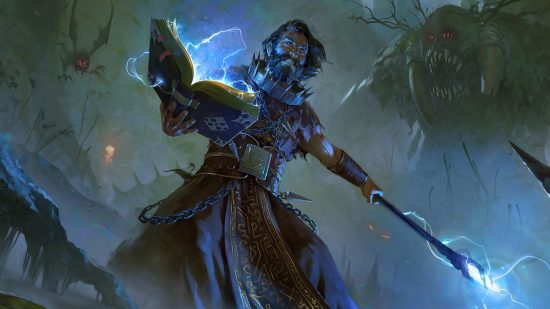The newly released Graven contains all of the hallmarks of the so-called ‘boomer shooter.’ Open-ended environments? Check. Searching for keys? Check? Demonic baddies? Check. But rather than cribbing from Doom or Wolfenstein 3D, its chief inspirations are two other id-published cult classics – Heretic and Hexen. Developed by Raven Software and released on PC back in 1994 and 1995 respectively, they transposed the 3D shooter to a dark fantasy setting, swapping pistols and rocket launchers for swords and magic.

In Graven, you step into the robes of a priest of the Orthogonal order, executed for the crime of defending his family. Despite the whole execution thing, our hero finds himself surprisingly alive and well once more, albeit purgatorially stranded in a swampy region infested with shambling undead, vicious beasts, and other unsavory inhabitants from the Kafkaesque to the Lovecraftian.
It seems you are this gloomy region’s only hope for salvation from the blight spreading through the land, and – luckily – there are plenty of tools at your disposal to help you get the job done. While it’s easiest to describe Graven as an FPS game, there’s not much shooting involved here. Combat largely takes the form of sword or staff-based melee attacks and spells, with the crossbow being the most traditional projectile weapon acquired early on.
You can cast spells via a spellbook that calls upon traditional elements such as fire and electricity. These can damage and inflict status effects on enemies but are also important for interacting with the world. You can use fire to burn away obstacles or destroy corpse piles, stopping the undead from rising to attack, while electricity is handy to power mechanisms or electrify water, creating a deadly trap for inattentive enemies. As you collect more spells, you’ll be able to open up and explore new areas, expanding the semi-open-world level design to varying degrees.
Collecting and upgrading these spells is a key progression driver in Graven, especially given that the narrative takes a light-touch approach and there’s no level-up mechanic. You can interact with various NPCs around the game’s gothic villages and holdfasts, and while key characters are fully voiced, most will respond with a grunt and few choice words. The player character jots down notes in his journal, giving you a glimpse into his psyche without him ever uttering a word.
The most striking thing about Graven is its visuals. The game evokes low-poly PC classics with its pixelated environments but now rendered in Unreal Engine 4, allowing the old-school textures to be enhanced with volumetric lighting. The player character also has detailed animations when compared to the basic movements of the majority of NPCs. This dissonance can feel jarring at first but begins to grow natural the longer you spend with it.
Its unique effect makes you feel like a visitor in this world of a bygone era. As new biomes are introduced, you’ll get to experience deserts, snowy castles, and more. While my first few hours were restricted to the boggy swamp environments, considering how long I spent playing around just in this first biome, I have to assume there’s a fair bit to venture through here, with each new open-ended environment offering fresh challenges and rewards.
Graven’s art design presents a novel way to express retro-style graphics and one that I expect will be divisive. Even if I don’t have a great deal of nostalgia for the likes of Heretic and Hexen, Graven’s reimagining of the cult classics feels authentic while adding a strong modern flourish. It won’t be for everyone, but Graven is an authentic trip down memory lane and one that is largely unique among modern PC games to boot.




